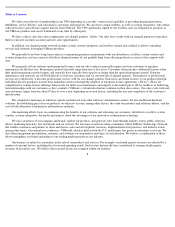VMware 2010 Annual Report Download - page 21
Download and view the complete annual report
Please find page 21 of the 2010 VMware annual report below. You can navigate through the pages in the report by either clicking on the pages listed below, or by using the keyword search tool below to find specific information within the annual report.
Table of Contents
Additionally, as more and more businesses achieve the virtualization of their data centers and other IT functions, the market for our
VMware vSphere product line may become saturated. If we fail to introduce compelling new features in future upgrades to our VMware vSphere
product line or develop new applications for our virtualization technology, demand for VMware vSphere may decline.
Due to our product concentration, our business, results of operations, financial condition, and cash flows would therefore be adversely
affected by a decline in demand for our data center virtualization products.
Our revenues, collection of accounts receivable and financial results may be adversely impacted by fluctuation of foreign currency exchange
rates. Although foreign currency hedges can offset some of the risk related to foreign currency fluctuations, we will continue to experience
foreign currency gains and losses in certain instances where it is not possible or cost effective to hedge our foreign currency exposures.
Our revenues and our collection of accounts receivable may be adversely impacted as a result of fluctuations in the exchange rates between
the U.S. Dollar and foreign currencies. For example, we have distributors in foreign countries that may incur higher costs in periods when the
value of the U.S. Dollar strengthens against foreign currencies. One or more of these distributors could delay payments or default on credit
extended to them as a result. Any significant delay or default in the collection of significant accounts receivable could result in an increased need
for us to obtain working capital from other sources. If we determine that the amount of accounts receivable to be uncollectible is greater than our
estimates, we would recognize an increase in bad debt expense, which would have a negative impact on our results of operations. In addition, in
periods when the value of the U.S. Dollar strengthens, we may need to offer additional discounts, reduce prices or offer other incentives to
mitigate the negative effect on demand.
Since the second quarter of 2009, we have invoiced and collected in certain non-U.S. Dollar denominated currencies, thereby conducting a
portion of our revenue transactions in currencies other than the U.S. Dollar. Although this program may alleviate credit risk from our distributors
during periods when the U.S. Dollar strengthens, it shifts the risk of currency fluctuations to us and may negatively impact our revenues,
anticipated cash flows and financial results due to fluctuations in foreign currency exchange rates, particularly the Euro, the British Pound, the
Japanese Yen and the Australian Dollar relative to the U.S. Dollar. While variability in operating margin may be reduced due to invoicing in
certain of the local currencies in which we also recognize expenses, increased exposure to foreign currency fluctuations will introduce additional
risk for variability in revenue-related components of our consolidated financial statements.
Since July 2009, we have entered into foreign currency forward contracts to hedge a portion of our net outstanding monetary assets and
liabilities against movements in certain foreign exchange rates. Although we expect the gains and losses on our foreign currency forward
contracts to generally offset the majority of the gains and losses associated with the underlying foreign-currency denominated assets and
liabilities that we hedge, our hedging transactions may not yield the results we expect. Additionally, we expect to continue to experience foreign
currency gains and losses in certain instances where it is not possible or cost effective to hedge our foreign currency exposures.
We are dependent on our management and our key development personnel, and the loss of key personnel may prevent us from implementing
our business plan in a timely manner.
Our success depends largely upon the continued services of our existing management. We are also substantially dependent on the
continued service of our key development personnel for product innovation. We generally do not have employment or non-compete agreements
with our existing management or development personnel and, therefore, they could terminate their employment with us at any time without
penalty and could
18
•
technological change that we are unable to address with our data center virtualization products; or
•
general economic conditions.
























